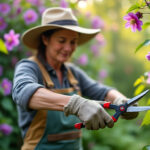Understanding the intricacies of fruit tree care is essential for any gardening enthusiast. With proper techniques and timing, one can enhance not only the aesthetic appeal of their garden but also the productivity of their fruit trees. In particular, knowing when to prune fruit trees is a critical aspect that should not be overlooked. This detailed guide explores various factors involved in the pruning process, offering comprehensive insights on achieving optimal growth for diverse varieties of fruit trees.
- Key considerations for pruning
- Timing for pruning fruit trees
- Understanding types of fruit trees
- Effective pruning techniques
- Best pruning tools and supplies
Key Considerations for Pruning
Pruning is an essential practice in horticulture, aiming to enhance tree health and fruit production. The process involves selectively removing branches to improve light exposure, air circulation, and overall structure. Various factors must be considered when approaching the pruning task:
- Tree Health: Evaluate the overall condition of the tree. Look for signs of disease, pests, or physical damage. Maintaining a healthy tree encourages robust growth.
- Seasonal Changes: Awareness of seasonal shifts is crucial. Different times of the year present various opportunities and challenges for pruning.
- Tree Type: Different species of fruit trees have specific growth habits and requirements. Familiarity with these aspects aids in tailoring the pruning technique accordingly.
- Growth Pattern: Recognizing the growth pattern of your tree helps in prioritizing which branches to remove or retain for optimal fruiting.
- Future Growth: Pruning should promote future growth. Consider how the removal of certain branches will affect the tree’s potential in the coming seasons.
By taking these factors into account, individuals can significantly improve the health and productivity of their fruit trees. Accurate assessment leads to judicious pruning practices, ensuring that trees flourish rather than suffer from excessive cutting.
Seasonal Changes Affecting Pruning
The timing of pruning is closely linked to seasonal changes. Trees exhibit different behaviors in response to the seasons, which directly influences the pruning schedules.
Typically, trees enter dormancy during the late fall and winter months. This is the best time to prune deciduous fruit trees, such as apple, cherry, and peach trees. During this period, they expend minimal energy, making recovery from pruning less challenging. Additionally, dormant pruning helps prevent excessive loss of sap and water.
In contrast, evergreen fruit trees, like citrus species, should be pruned after the last frost in early spring. Pruning during this time encourages healthy regrowth while protecting the tree from potential cold damage.
Timing for Pruning Fruit Trees
Proper timing in pruning ensures that fruit trees thrive and produce maximum harvests. Here are several timeframes to consider based on specific tree types:
| Fruit Tree Type | Best Pruning Time | Key Considerations |
|---|---|---|
| Deciduous Trees (e.g., apple, peach) | Late winter to early spring | Encourages strong new growth, reduces stress |
| Evergreen Trees (e.g., citrus) | After last frost in spring | Avoids frost damage, promotes vigorous growth |
| Summer Pruning (e.g., peach) | Immediately after harvest | Limits growth, maintains tree shape |
| Younger Trees | Regular seasonal checks, ideally during dormancy | Facilitates healthy development and structure |
By adhering to these timelines, gardeners can craft a comprehensive pruning strategy tailored to their trees’ growth patterns and overall health.
Benefits of Proper Timing
The advantages of understanding and applying appropriate pruning times are significant. Proper timing fosters not only vigorous vegetative growth but also fruitful yields:
- 🍎 Improved Yields: Trees pruned at the right time produce higher quality fruit.
- 🌳 Enhanced Tree Health: Well-timed pruning minimizes stress and promotes recovery.
- 🌞 Better Light Exposure: Pruning opens up the canopy, allowing more sunlight to reach all branches.
- 🔄 Disease Prevention: Removing diseased branches early prevents illness from spreading to healthy areas.
- 🌱 Controlled Growth: Effective pruning shapes trees while mitigating issues of overcrowding and competition for resources.
Understanding these benefits encourages thoughtful management of tree care practices, enhancing both tree aesthetics and productivity.
Understanding Types of Fruit Trees
Grasping the distinction between deciduous and evergreen fruit trees is fundamental to developing effective pruning practices:
- 🔄 Deciduous Trees: These trees lose their leaves in winter and enter dormancy, making them suitable for late winter pruning.
- ☘️ Evergreen Trees: These retain their foliage throughout the year. Pruning should be done in spring post-frost to support vigorous new growth.
Examples of common fruit trees in these categories include:
| Type of Tree | Examples | Pruning Recommendations |
|---|---|---|
| Deciduous | Apple, Cherry, Peach | Late winter or early spring pruning |
| Evergreen | Citrus (Lemon, Orange) | Spring pruning after frost |
By recognizing the needs of each category, gardeners can successfully navigate the intricate balance of nurturing their trees for optimal health and production.
Caring for Younger Trees
Younger trees significantly benefit from regular pruning, especially in their formative years. Proper pruning practices in this period can dictate the future health and productivity of the tree:
- 🌱 Encourages Strong Structure: Pruning influences the growth patterns, directing energy toward forming a solid base.
- 📅 Tailored Cuts: Targeted cuts can help develop an ideal canopy structure, essential for long-term production.
- ⚖️ Balance Preservation: Regularly assessing and pruning younger trees maintains equilibrium between root and canopy development.
Establishing good pruning habits early on allows these trees to flourish, leading to abundant fruit production in later stages.
Effective Pruning Techniques
Implementing effective pruning techniques not only maximizes productivity but also maintains tree health. Key techniques worth mastering include:
Thinning Cuts versus Heading Cuts
Both thinning and heading cuts serve distinct purposes, and knowing how to utilize each effectively is essential:
- 🌳 Thinning Cuts: Involve removing entire branches back to a lateral branch or bud. This technique promotes air circulation and enhances sunlight exposure, crucial for healthy fruit development.
- 🌿 Heading Cuts: Shortening a branch by cutting it back encourages bushier growth and can help shape the tree for better aesthetics and productivity.
| Technique | Purpose | Best Use Cases |
|---|---|---|
| Thinning Cuts | Improves air circulation and light penetration | To manage overcrowded branches |
| Heading Cuts | Encourages new growth | For shaping and compacting trees |
By employing the correct technique according to the situation, gardeners can optimize their fruit trees for sustained growth and high yields.
When to harvest maincrop potatoes for the best yield
Best Pruning Tools and Supplies
Utilization of appropriate pruning tools plays a vital role in achieving optimal results. Here’s a list of essential pruning supplies that should be included in any gardening arsenal:
- 🔪 Tree Pruning Shears: Ideal for precise cuts, and best suited for small branches.
- ✂️ Loppers: These heavy-duty tools help tackle thicker branches efficiently.
- 🪚 Hand Saw: Essential for larger limbs that cannot be managed with loppers.
- 🧤 Gloves: Protect the hands while providing a better grip on the tools.
- 🧴 Disinfecting Solution: Keeping tools clean reduces the risk of transmitting diseases between trees.
Having the right gardening supplies ensures that pruning is performed efficiently and effectively, minimizing stress on the trees while maximizing the potential for healthy growth.
| Tool | Function | Recommended Use |
|---|---|---|
| Tree Pruning Shears | For precise cutting of small branches | General maintenance |
| Loppers | Trimming thicker branches | Branches up to 2 inches |
| Hand Saw | For heavy-duty cuts | Larger branches beyond lopper capacity |
Investing in quality tools leads to better pruning outcomes and contributes to the long-term health and productivity of fruit trees.
Regular Inspections and Maintenance
In addition to proper pruning techniques, conducting regular inspections of fruit trees is crucial. These inspections should focus on:
- 🔍 Pest Management: Look for signs of pests during pruning to tackle infestation early.
- 🌡️ Disease Monitoring: Identifying any diseases can allow for timely intervention strategies.
- 🌳 Structural Evaluation: Regular assessments help maintain tree health and structure.
Consistent maintenance and vigilance in monitoring tree health lay the foundation for a productive fruit garden.
FAQ
- When is the best time to prune fruit trees?
- Pruning fruit trees is best done in late winter or early spring, while trees are still dormant. This timing helps encourage strong growth and enhances fruit production.
- How does improper pruning timing affect fruit trees?
- Improper pruning timing can lead to poor fruit yields or even damage the trees. It’s essential to prune at the right time to promote healthy growth and maximize fruit output.
- What are the types of fruit trees and their pruning needs?
- Fruit trees fall into two categories: deciduous and evergreen. Deciduous trees, like apples and peaches, are pruned in late winter. Evergreen trees, such as citrus, are pruned after the last frost in spring.
- What techniques should I use for pruning deciduous trees?
- For deciduous trees, focus on removing dead, damaged, or crowded branches to improve air circulation and sunlight exposure. Inspect for pests and diseases during pruning.
- What is the purpose of summer pruning?
- Summer pruning, typically done from June to August, aims to control growth and shape trees. For some fruit trees, like peaches, prune immediately after harvest to maintain shape and direct energy toward fruit production.
















